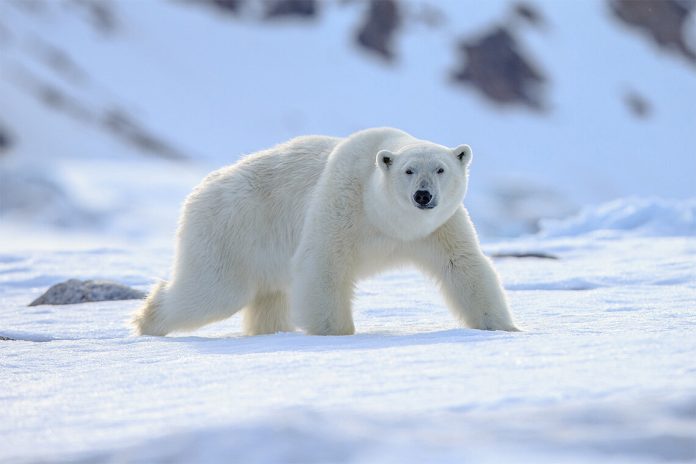Various news outlets are reporting this week that retreating summer sea ice from global warming is forcing polar bears to make “long, increasingly perilous swims, sometimes hundreds of miles long, to reach habitable ice.” The study, published in the most recent journal Ecography, tries to link long-distance swimming from declining Beaufort Sea sea ice to the population crash of polar bears in the mid-2000s. But the hype and the reality diverge at this point.
Because of a lack of summer sea ice, the study says, and ice floes spread further apart, polar bears are having to swim longer and some are getting trapped on ice out at sea. There’s only one problem. There wasn’t a single documented case of a polar bear drowning or being harmed by yearly summer ice retreat in the study. And despite the hype and misleading media, polar bear populations have been thriving as Crockford pointed out last July.
Scientists from from the University of Alberta and Environment and Climate Change Canada, which spearheaded the study, said the Beaufort Sea “polar bear population has fallen more than 50 percent in the past 10 years.” Andrew Derocher, a University of Alberta biologist who co-authored the report with lead author Nicholas Pilford, said: “So it is a concern that this is probably one of the factors associated with the population decline.”
From 2004 to 2006, there was a polar bear population crash, writes zoologist and polar bear expert Dr. Susan J. Crockford, but it had nothing to do with a lack of sea ice or global warming. Crockford, who has studied and written about polar bears for over 35 years, notes that this population crash in the southern Beaufort sea was actually caused by “thick spring ice that drove pregnant ringed seals away.” Yes, the spring ice was too thick. This is a “well-documented phenomenon,” she writes, and it has “occurred about every 10 years, [going] back to at least the 1960s.”
Crockford says that the polar bear population, Beaufort Sea spring ice, and ringed seal survival are inextricably linked. Spring feeding is also when polar bears do the bulk of their feeding and storing of fat, and eat very little during the summer. During this time (April to June), the “period of on-ice birth and nursing for ice-dependent seals” coincides “when polar bears consume two-thirds of their annual prey.” And plump, blubber-rich ringed seals are a vital part of a polar bear’s diet.
Even the study admits that there was “no direct evidence that long-distance swimming killed any of the polar bears” (100 female bears are tagged and monitored by GPS collars). And this same type of population crash occurred from 1974 to 1976 and was “every bit as deadly,” but unlike today, Crockford notes, no one blamed global warming. The study also found no way to track the survival of the cubs, and again Crockford points out that the young bears didn’t die because they had to swim too much, but rather “they starved to death due to lack of ringed seal pups to eat in the spring.”
And contrary to Derocher’s statement, the Beaufort Sea polar bear population fell about 40 percent in the past 10 years, largely because of the 2004-2006 crash. Bramaghin et al released a study in 2014 showing that the population decline was caused by thick spring ice. “Conservatively, the decline seems unlikely to have been less than 25% but may have approached 40%,” that study also said. “Improved survival and stability in abundance at the end of the investigation are cause for cautious optimism.”
The only evidence of harm, Crockford notes, came from a previous studythat found one female bear who swam “continuously for nine days without food or rest” in September. It also walked 53 days over ice (more than two months). She lost 22 percent of her body weight, “at a time she would have been losing weight” anyways. That’s because polar bears “eat very little during the summer,” despite another misleading study.
And despite all the hype, the female bear was not “dangerously thin” after her “ordeal” (she weighed 177 kilograms / 390 pounds), and the researchers still have no idea what happened to her cub. That didn’t stop various news outlets from reporting that polar bear cubs are drowning from long-distance swimming from retreating sea ice due to global warming. In other words, Crockford says, “No one knows how the cub died – they just know it wasn’t with its mother when she was re-captured. it could have been eaten by another bear or suffered some other kind of accidental death.”
Crockford also says the study shows, “no bears died while swimming during the two lowest sea ice extent summers since 1979 and no evidence was presented that swims were ‘particularly hard on mothers with young cubs.’ She added: “Despite what may be implied during media moments, Beaufort Sea polar bears were not frantically trying to reach the sea ice from land so that they could attempt to keep feeding over the summer.”
She also reiterated this study combined two different groups of polar bear populations: Beaufort Sea and Hudson Bay bears. Beaufort Sea bears “spend the summer on the sea ice while Hudson Bay bears spend the summer on shore.” They also didn’t track male polar bears because their necks are too wide and they remove their GPS collars. And “most of their swimming was done during breakup in July and August from one bit of pack ice to another and they showed no evidence of harm” from swimming.
Tracking observations of the two unique populations showed Hudson Bay bears were “unimpressive” and despite all the media hype, none of the Beaufort Sea bears died from long-distance swimming.















